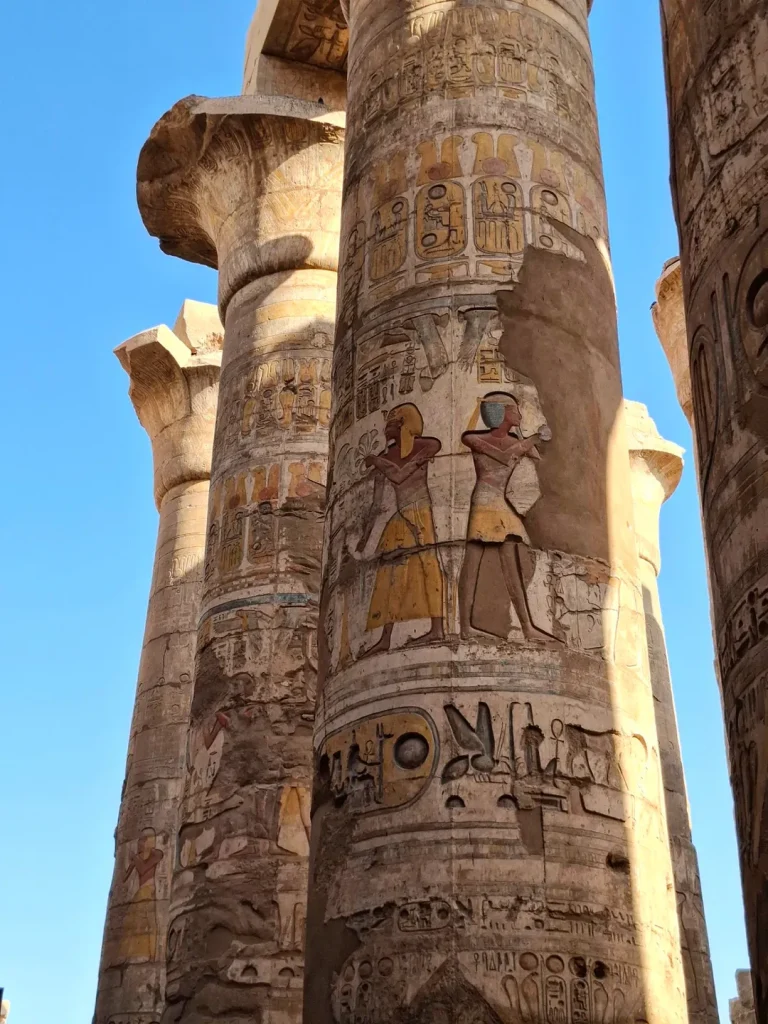Karnak Hypostyle Hall
huge multi-columned hall
Visiting the Great Hypostyle Hall at Karnak feels like stepping into another time. The tall columns rise around you, with their tops shaped like papyrus plants nearly touching the sky. This hall is a must-see for anyone exploring Luxor and wanting to understand ancient Egyptian culture. It is part of the Karnak Temple Complex, one of the largest religious sites ever built. The Hypostyle Hall shows the dedication, artistry, and architectural skill of the pharaohs over many years. Whether you’re interested in archaeology, photography, or enjoy exploring, this sacred space offers a memorable glimpse into history.

History of the Great Hypostyle Hall
The Great Hypostyle Hall is a pivotal component of ancient Egypt’s history, particularly during the New Kingdom period, spanning approximately 1550 to 1070 BCE. Its beginnings go back to the Middle Kingdom (about 2055 to 1650 BCE), when the god Amun became very important in Thebes. The idea for a grand hypostyle hall, with rows of columns holding up a roof, started to take shape when Seti I became king around 1290 BCE.
Ramesses II, who ruled from 1279 to 1213 BCE, continued the construction. He added many features to Karnak, finished the central nave, put up inscriptions about his military victories, and expanded the walls around the hall. By the end of the New Kingdom, the Hypostyle Hall featured 134 columns in 16 rows, covered more than 5,000 square meters, and had a roof supported by large stone architraves.
Luxor Tours & Activities
Looking to save some costs on your travel? Why not join a shared group tour to explore Luxor, Egypt? Here are some activities you might be interested in:
Architectural Marvels of the Great Hypostyle Hall
Ancient Egyptian architects created the Hypostyle Hall to amaze visitors and emphasize the power of the pharaohs. The hall’s two main features are its large columns and the detailed carvings on their shafts and tops.

Monumental Columns
- Total number: 134
- Height: central columns reach almost 24 meters; side columns about 10 meters
- Diameter: up to 3 meters at the base
- Layout: central nave formed by two rows of taller columns; side aisles lined with shorter columns
Walking down the main aisle feels like entering a stone forest, with sunlight coming through narrow windows above. Each column is huge, showing the skill of New Kingdom builders. They cut sandstone blocks from the Nile’s eastern banks and moved them miles over land and water.

Hieroglyphs, Reliefs & Symbolism
Every surface in the Hypostyle Hall tells a story. The walls and columns display hieroglyphic writings that record royal families, religious offerings, and important battles, especially the reliefs of the “Battle of Kadesh,” which celebrate Ramesses II’s military skills. Lower carvings show offerings, priestly rituals, and scenes of pharaohs worshipping Amun. These reliefs are not only beautiful but also help worshipers understand ceremonies and reinforce the cosmic order that the gods and their representatives on Earth maintain.

Exploring the Great Hypostyle Hall: What to See
When you arrive at the Hypostyle Hall, take your time to explore both the grand views and hidden details. Here are the key highlights you should see:
– The central avenue with tall columns topped with papyrus capitals
– Reliefs in the south-west corner showing the victories of Ramesses II
– Faint traces of color on the reliefs, offering a glimpse of the hall’s original paint
– Detached pieces from the White Chapel of Senusret I, moved during modern restorations
– Graffiti left by ancient visitors and Roman soldiers, showing centuries of admiration
Don’t rush. Close your eyes, and picture the flickering torchlight on the hieroglyphs as priests and pharaohs walked through the hall during festivals.
Got a Question?
F.A.Qs
The Great Hypostyle Hall is a massive columned hall inside the Karnak Temple Complex in Luxor, Egypt. Built mainly by Seti I and Ramesses II, it contains 134 towering sandstone columns arranged in 16 rows, covering over 5,000 square meters.
It’s considered one of the greatest architectural achievements of ancient Egypt. The hall’s colossal columns, intricate hieroglyphs, and sheer scale make it one of the most photographed and studied monuments in Luxor.
Construction began around 1290 BCE under Seti I and was completed by his son, Ramesses II, during the 19th Dynasty—making it over 3,200 years old.
It served as a ceremonial space for religious rituals, processions, and offerings to Amun-Re. The hall symbolized the primeval marshes of creation, with columns shaped like papyrus stalks.
Did you know that
By purchasing through our links, you support us at no additional cost.
Thank you for your support. ♥️






